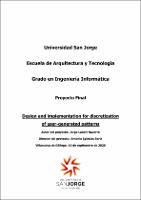Por favor, use este identificador para citar o enlazar este ítem:
https://repositorio.usj.es/handle/123456789/426
Registro completo de metadatos
| Campo DC | Valor | Lengua/Idioma |
|---|---|---|
| dc.contributor.advisor | Iglesias Soria, Antonio | - |
| dc.contributor.author | Lacort Navarro, Jorge | - |
| dc.date.accessioned | 2020-11-06T10:43:43Z | - |
| dc.date.available | 2020-11-06T10:43:43Z | - |
| dc.date.issued | 2020 | - |
| dc.date.submitted | 2020-09-11 | - |
| dc.identifier.uri | https://repositorio.usj.es/handle/123456789/426 | - |
| dc.description | Design and development of a game mechanic to define unit formations in RTS videogames, allowing the user to draw a line as a polygonal chain in the game scenario, which becomes the unit formation, filling the line with all the elements selected and expanding it by creating new rows of units around the line if needed. The main issue is to design a solution which works for any possible line drawn by the user in real-time and with a time complexity limit O(n2). Due to its novelty in the RTS genre, this game mechanic could be a selling point for the videogame in which it has been integrated. While finding a design which works for all cases is difficult by itself, having both the possibility of the user drawing lines as complex as they want and the limit in time complexity required, is what makes this problem particularly challenging. In this document we present a solution implemented, thought, it would still need some polishing before being released. | es_ES |
| dc.description.abstract | Diseño y desarrollo de mecánica de juego para definir formaciones de unidades en videojuegos RTS, permitiendo al usuario dibujar una línea como una cadena poligonal en el escenario del juego, que se convierte en una formación de unidad, rellenando la línea con todos los elementos seleccionados y expandiéndola al crear nuevas filas de unidades alrededor de la línea en caso de que sea necesario. El principal problema es diseñar una solución que funcione para cualquier línea dibujada por el usuario en tiempo real y con una complejidad en tiempo O(n2). Al ser una novedad en el género RTS, esta mecánica de juego podría ayudar al atractivo comercial del videojuego en el que se ha integrado. Aunque ya es difícil encontrar un diseño que funcione para todos los casos, tener en cuenta que el usuario pueda dibujar líneas tan complicadas como quieran con el límite de complejidad en tiempo requerido, es lo que hace este problema particularmente complicado. En este documento presentamos una solución implementada, aunque sería necesario mejorarla antes de su lanzamiento al mercado. | es_ES |
| dc.format.extent | 82 p. | es_ES |
| dc.format.mimetype | application/pdf | es_ES |
| dc.language.iso | spa | es_ES |
| dc.language.iso | eng | es_ES |
| dc.relation.requires | Adobe PDF | es_ES |
| dc.rights | Attribution-NonCommercial-NoDerivatives 4.0 Internacional | * |
| dc.rights.uri | http://creativecommons.org/licenses/by-nc-nd/4.0/ | * |
| dc.subject | RTS | es_ES |
| dc.subject | Real-time strategy | es_ES |
| dc.subject | Unit formation | es_ES |
| dc.subject | Polygonal chain | es_ES |
| dc.subject | Pattern | es_ES |
| dc.subject | Visual pattern | es_ES |
| dc.subject | Geometry | es_ES |
| dc.subject | Computational geometry | es_ES |
| dc.subject | Graph theory | es_ES |
| dc.subject | Cycle | es_ES |
| dc.subject | Chordless cycle | es_ES |
| dc.title | Design and implementation for discretization of user-generated patterns | es_ES |
| dc.type | info:eu-repo/semantics/bachelorThesis | es_ES |
| dc.subject.unesco | Lenguaje de programación | es_ES |
| dc.subject.unesco | Diseño por ordenador | es_ES |
| dc.rights.accessrights | info:eu-repo/semantics/openAccess | es_ES |
| Aparece en las colecciones: | Grado en Diseño y Desarrollo de Videojuegos | |
Ficheros en este ítem:
| Fichero | Descripción | Tamaño | Formato | |
|---|---|---|---|---|
| Jorge Lacort Navarro - Design and implementation of discretization of pattern generated by user.pdf | 2,91 MB | Adobe PDF |  Visualizar/Abrir |
Este ítem está sujeto a una licencia Creative Commons Licencia Creative Commons

